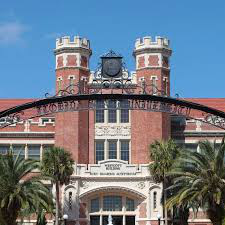Conveners
Nuclear Strangeness: Parallel 4
- Jiri Mares
Nuclear Strangeness: Parallel 3
- Megumi Naruki
The measurement of the production, the lifetime and the binding energy of the hypertriton with the ALICE detector at the LHC is presented to address some of the key open questions of hypernuclear and particle physics.
The hypertriton is a bound state of a proton (p), a neutron (n) and a Λ and it is characterized by a very low binding energy and a large wave function. It is still unclear how...
The hyperon-nucleon (Y-N) interaction is an important ingredient in the description of the equation-of-state of high-baryon-density matter. Light hypernuclei ($A=3, 4$), being simple Y-N bound states, are cornerstones of our understanding of the Y-N interaction. Precise measurements of the lifetimes and binding energies of light hypernuclei are of particular interest.
Light hypernuclei are...
We report on our recent leading order pionless effective field theory (LO pionless EFT) studies [1,2,3,4,5] of light single- and double-Lambda hypernuclei. These systems are within the focus of current experimental interest since their spectra provide strong constraints in a study of the 2- and 3-body interaction between $\Lambda$ hyperons and nucleons. Application of LO pionless EFT, fitted...
Direct ΛN scattering data is extremely important and needed based on the newly confirmed Charge-Symmetry-Breaking (CSB) at a level of ~230 keV from the binding energy difference observed between ground states of $^4_Λ$He and $^4_Λ$H. Especially, the Λn data does not exist at all, thus the properties of Λn interaction has been assumed to be identical to that of Λp interaction. The resonance of...
We investigate 𝑆=−1 and −2 hypernuclei with 𝐴=4−7 employing the Jacobi-NCSM approach [1] and in combination with baryon-baryon (BB) interactions derived within the frame work of chiral effective field theory. The employed BB interactions are softened using the so-called similarity renormalization group (SRG) [2] in order to speed up the convergence. Such a SRG evolution is only approximately...
The existence of a quasi-bound state of antikaon and nucleus, kaonic nucleus, has been discussed ever since the $\bar{K}N$ interaction in $I=0$ channel was confirmed to be strong attractive. The $\bar{K}NN$ quasi-bound state is the lightest kaonic nucleus which is considered to be $I=1/2$ and $J^\pi = 0^-$. To search for the $I_z=+1/2~\bar{K}NN$ state we conducted the J-PARC E15 experiment...
Scattering experiments involving a hyperon and a proton are the most effective methods for investigating two-body hyperon–nucleon (𝑌𝑁) interactions, as is the case in various intensive studies on 𝑝𝑝 and 𝑛𝑝 scattering, which are aimed at understanding nucleon–nucleon (𝑁𝑁) interactions. Scattering observables, such as differential cross sections and spin observables, are essential experimental...
Spectroscopy of hypernuclei with strangeness $-2$ is important to extract information on hyperon-nucleon and hyperon-hyperon interactions. In J-PARC, followed by a hybrid-emulsion experiment, a series of counter experiments with a newly constructed high-resolution spectrometer S-2S will be performed in near future. In particular, We propose an experiment (J-PARC E75 experiment) to investigate...
The bound system of an antikaon ($\bar{K}$) and nucleons has been widely discussed based on the strong $\bar{K}N$ attraction in the isospin zero channel (I = 0). The attraction leads the much deeper binding energy of kaonic nuclei compared to that of normal nuclei. The simplest kaonic nuclei system, $\bar{K}NN$, has been one of the most expected states to be observed in the interest energy...

